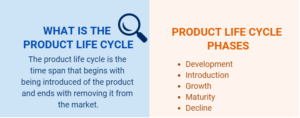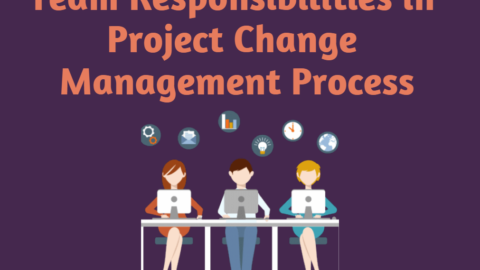Product Life Cycle vs Project Life Cycle
Why does a project manager need to understand both the project life cycle and the product life cycle? Because Project Life Cycle vs Product Life Cycle is a significant topic that every project manager must know. Although they sound quite similar, they refer to different concepts. But what is the difference between them? Many PMP aspirants ask this question, therefore we decided to write this article to clarify the main differences between these two significant concepts.
Table of Contents
What is the Project Life Cycle?

Mostly, projects are performed to create a product and once the product is created, the project comes to an end.
Whether you manage a large construction project or a piece of software development project, you follow similar project management processes. Basically, the project life cycle consists of sequential and overlapping phases which are specified and documented for the project management needs of the organization.
Project Life Cycle Phases
The Project Life Cycle typically includes five phases;
- Initiation
- Planning
- Executing
- Controlling
- Closing
These phases will vary depending on the industry, organization, or the type of project that is being executed. Monitoring and controlling is a part of every process at different phases. All the phases have different characteristics. Projects of the same organization may implement the same phases according to the organizational needs.
The initiation phase involves creating the project charter and identifying the project stakeholders.
In the planning phase, the project management plan which creates a roadmap for managing the project is created.
The executing phase involves a number of steps such as building the project and performing the project scope.
The monitoring and controlling phase involves tracking project performance and making analyses to understand if the project is on track or deviated from its original plan.
Finally, the closing phase comes up which involves practices to hand over the project to the client.
Before discussing the product life cycle, let’s take a glance at the example for a better understanding.
Characteristics
Below are a few characteristics of a project life cycle;
- Risks are high at the beginning of a project and start to decrease as it moves forward.
- Employment is lowest at the beginning, highest during the execution, and decrease towards completion.
- Most of the resources and funds are used during the execution.
- Stakeholder interest is higher at the beginning and gets decreased as the project progresses.
Project Life Cycle Example
Assume that you have a project to create new software. First, you will create the project charter and identify the key project stakeholders. Then you will develop the project management plan and create the project schedule. After that, the coding phase will start in which you write the codes of the software.
Finally, you hand over the software to the client, and the project will be closed. This is a simple example of the life cycle of a project.
What is the Product Life Cycle?

You are participating in various phases of the product life cycle in your everyday life. Is it interesting?
Suppose you are cleaning your garage. While you are changing the places of old items, you see video games from your childhood. Thus, you are experiencing various evolution phases of computer games.
A new product is often unbeknownst at the beginning. During its life cycle, it becomes useful and provides benefits to the customers. Finally, it will become out of date and vanquished if it does not march with the times.
Typically, the product life cycle consists of sequential and non-overlapping phases which are specified and documented by the needs of the organization. The product life cycle is the time span that begins with being introduced of the product and ends with removing it from the market.
Now let’s take a look at the phases one by one.
Product Life Cycle Phases
Below are the phases of the product life cycle
- Development
- Introduction
- Growth
- Maturity
- Decline
The development phase starts when the company generates the idea to create the product. This phase also includes the creation of the product.
Once the product is created the introduction phase comes into play in which the product is introduced to the market.
During the growth phase, potential customers become aware of the product. Therefore sales and revenues begin to increase and profits begin to accrue.
In the maturity phase, sales are at the peak but sales growth slows down. During this phase, the product gains wide acceptance by the customers. However, profits decrease due to competition and advertisement costs.
The last phase is the decline phase in which growth becomes negative and profits decline. Because the sales amount is not enough to support its production cost.
Depending on the product and market demand duration of product life cycle phases varies. For example, the development phase of a car may take two years. However, the maturity phase may take 50 years.
Not all products follow all five stages. Some products quickly decline right after their introduction. However, there are many products still in their maturity stage such as COCA-COLA.
Generally, The Product Life Cycle phases may involve a number of Project Life Cycles because the product life cycle continues to exist after the project is finished.
For better understanding, let’s review a simple example for software development.
Product Life Cycle Example
Assume that your company generated an idea to create a piece of software and sell it in the market. Then, you completed the coding phase and created the product. First, you introduced this product to the market and started selling. After that sales and profits increased. Depending on the market demand and competition, your growth became negative and profits declined.
PLC Analysis
Companies often perform PLC Analysis (product life cycle analysis) to understand if their products are favored in the market, and when it is needed to take the necessary actions.
They examine a number of parameters such as competitor analysis, sales performance, and expenses to decide how to develop their products considering requirements. PLC Analysis provides a general insight to companies regarding where their products are and how to increase sales.
PLC Strategies
Before discussing project life cycle vs product life cycle in detail, let’s take a look at PLC Strategies. Companies develop various strategies such as price skimming or price penetration to increase awareness and sales on time. If they don’t evaluate the performance of their products correctly during the introduction stage, they will face many problems. PLC Analysis helps companies to develop strategies to grow.
Difference Between Project Life Cycle and Product Life Cycle
There are many differences between these two concepts. Below are a few differences between them.
• The Project Life Cycle may involve overlapping phases while The Product Life Cycle involves non-overlapping phases.
• The Product Life Cycle phases may involve many Project Life Cycles
• The Product Life Cycle focuses on the product. On the other hand, The Project Life Cycle focuses on the project.
• The Product Life Cycle depends on market conditions and needs. On the other hand, The Project Life Cycle may or may not depend on market conditions. The project life cycle plans the steps required to complete the project with specific goals.
Summary
Every project or product has certain phases of development from the beginning to the end. Different industries, organizations, and project types involve different project life cycles. On the other hand, The Product Life Cycle focuses on the product and does not change based on the product type. Although they refer to different concepts, they are related to each other.
Because of a number of factors such as increased competition, decreased demand, or customer dissatisfaction, finally, all products become outdated. Companies often perform PLC Analysis in order to analyze the progress of a product through its life cycle.
Understanding each concept and having knowledge about its use will help the project management practitioners to integrate both into their business processes with maximum effectiveness. Note that this is a significant concept for the PMP Certification Exam.
External Reference

Vice President, İntelligent Design & Consultancy Ltd
Over 12 years of global & rich experience in Portfolio & Program Delivery Management in leading & managing IT Governance, PMO, IT Portfolio/Program, IT Products, IT service delivery management, Budget Management, and more.











Great explanation
Thanks a lot